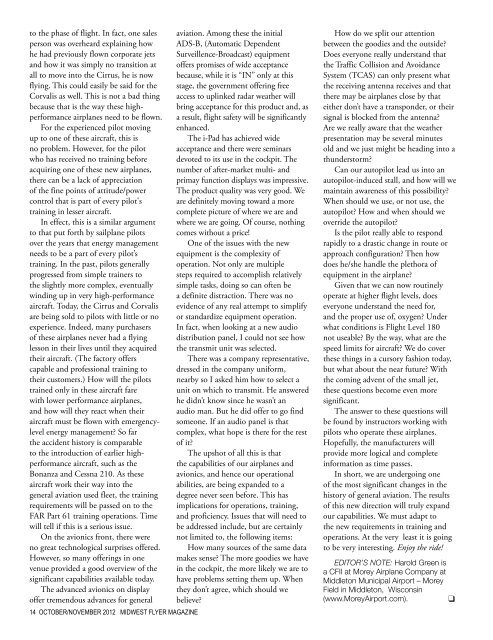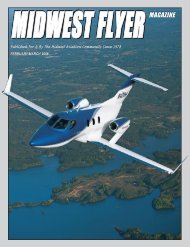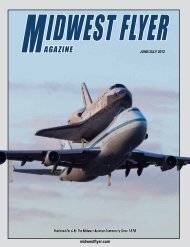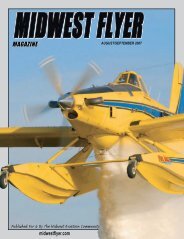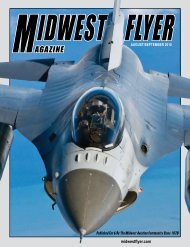You also want an ePaper? Increase the reach of your titles
YUMPU automatically turns print PDFs into web optimized ePapers that Google loves.
to the phase of flight. In fact, one salesperson was overheard explaining howhe had previously flown corporate jetsand how it was simply no transition atall to move into the Cirrus, he is nowflying. This could easily be said for theCorvalis as well. This is not a bad thingbecause that is the way these highperformanceairplanes need to be flown.For the experienced pilot movingup to one of these aircraft, this isno problem. However, for the pilotwho has received no training beforeacquiring one of these new airplanes,there can be a lack of appreciationof the fine points of attitude/powercontrol that is part of every pilot'straining in lesser aircraft.In effect, this is a similar argumentto that put forth by sailplane pilotsover the years that energy managementneeds to be a part of every pilot’straining. In the past, pilots generallyprogressed from simple trainers tothe slightly more complex, eventuallywinding up in very high-performanceaircraft. Today, the Cirrus and Corvalisare being sold to pilots with little or noexperience. Indeed, many purchasersof these airplanes never had a flyinglesson in their lives until they acquiredtheir aircraft. (The factory offerscapable and professional training totheir customers.) How will the pilotstrained only in these aircraft farewith lower performance airplanes,and how will they react when theiraircraft must be flown with emergencylevelenergy management? So farthe accident history is comparableto the introduction of earlier highperformanceaircraft, such as theBonanza and Cessna 210. As theseaircraft work their way into thegeneral aviation used fleet, the trainingrequirements will be passed on to theFAR Part 61 training operations. Timewill tell if this is a serious issue.On the avionics front, there wereno great technological surprises offered.However, so many offerings in onevenue provided a good overview of thesignificant capabilities available today.The advanced avionics on displayoffer tremendous advances for general14 OCTOBER/NOVEMBER 2012 MIDWEST FLYER MAGAZINEaviation. Among these the initialADS-B, (Automatic DependentSurveillence-Broadcast) equipmentoffers promises of wide acceptancebecause, while it is “IN” only at thisstage, the government offering freeaccess to uplinked radar weather willbring acceptance for this product and, asa result, flight safety will be significantlyenhanced.The i-Pad has achieved wideacceptance and there were seminarsdevoted to its use in the cockpit. Thenumber of after-market multi- andprimay function displays was impressive.The product quality was very good. Weare definitely moving toward a morecomplete picture of where we are andwhere we are going. Of course, nothingcomes without a price!One of the issues with the newequipment is the complexity ofoperation. Not only are multiplesteps required to accomplish relativelysimple tasks, doing so can often bea definite distraction. There was noevidence of any real attempt to simplifyor standardize equipment operation.In fact, when looking at a new audiodistribution panel, I could not see howthe transmit unit was selected.There was a company representative,dressed in the company uniform,nearby so I asked him how to select aunit on which to transmit. He answeredhe didn’t know since he wasn’t anaudio man. But he did offer to go findsomeone. If an audio panel is thatcomplex, what hope is there for the restof it?The upshot of all this is thatthe capabilities of our airplanes andavionics, and hence our operationalabilities, are being expanded to adegree never seen before. This hasimplications for operations, training,and proficiency. Issues that will need tobe addressed include, but are certainlynot limited to, the following items:How many sources of the same datamakes sense? The more goodies we havein the cockpit, the more likely we are tohave problems setting them up. Whenthey don’t agree, which should webelieve?How do we split our attentionbetween the goodies and the outside?Does everyone really understand thatthe Traffic Collision and AvoidanceSystem (TCAS) can only present whatthe receiving antenna receives and thatthere may be airplanes close by thateither don’t have a transponder, or theirsignal is blocked from the antenna?Are we really aware that the weatherpresentation may be several minutesold and we just might be heading into athunderstorm?Can our autopilot lead us into anautopilot-induced stall, and how will wemaintain awareness of this possibility?When should we use, or not use, theautopilot? How and when should weoverride the autopilot?Is the pilot really able to respondrapidly to a drastic change in route orapproach configuration? Then howdoes he/she handle the plethora ofequipment in the airplane?Given that we can now routinelyoperate at higher flight levels, doeseveryone understand the need for,and the proper use of, oxygen? Underwhat conditions is Flight Level 180not useable? By the way, what are thespeed limits for aircraft? We do coverthese things in a cursory fashion today,but what about the near future? Withthe coming advent of the small jet,these questions become even moresignificant.The answer to these questions willbe found by instructors working withpilots who operate these airplanes.Hopefully, the manufacturers willprovide more logical and completeinformation as time passes.In short, we are undergoing oneof the most significant changes in thehistory of general aviation. The resultsof this new direction will truly expandour capabilities. We must adapt tothe new requirements in training andoperations. At the very least it is goingto be very interesting. Enjoy the ride!EDITOR’S NOTE: Harold Green isa CFII at Morey Airplane Company atMiddleton Municipal Airport – MoreyField in Middleton, Wisconsin(www.MoreyAirport.com). q


